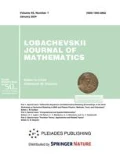Abstract
The density functional theory (DFT) is a research tool of the highest importance for electronic structure calculations. It is often the only affordable method for ab initio calculations of complex materials. The pseudopotential approach allows reducing the total number of electrons in the model that speeds up calculations. However, there is a lack of pseudopotentials for heavy elements suitable for condensed matter DFT models. In this work, we present a pseudopotential for uranium developed in the Goedecker–Teter–Hutter form. Its accuracy is illustrated using several molecular and solid-state calculations.
Similar content being viewed by others

References
K. Lejaeghere et al., “Reproducibility in density functional theory calculations of solids,” Science 351 (6280), aad3000 (2016).
H. Hellmann, “A new approximation method in the problem of many electrons,” J. Chem. Phys. 3, 61 (1935).
V. Heine and I. Abarenkov, “A new method for the electronic structure of metals,” Philos. Mag. 9, 451–465 (1964).
N. S. Mosyagin, A. V. Zaitsevskii, L. V. Skripnikov, and A. V. Titov, “Generalized relativistic effective core potentials for actinides,” Int. J. Quantum Chem. 116, 301–315 (2016).
G. Kresse and J. Joubert, “From ultrasoft pseudopotentials to the projector augmented-wave method,” Phys. Rev. B 59, 1758–1775 (1999).
D. E. Smirnova, S. V. Starikov, and V. V. Stegailov, “Interatomic potential for uranium in a wide range of pressures and temperatures,” J. Phys.: Condens.Matter 24, 015702 (2012).
S. Goedecker, M. Teter, and J. Hutter, “Separable dual-space Gaussian pseudopotentials,” Phys. Rev. B 54, 1703–1710 (1996).
C. Hartwigsen, S. Goedecker, and J. Hutter, “Relativistic separable dual-space Gaussian pseudopotentials from H to Rn,” Phys. Rev. B 58, 3641–3662 (1998).
J. Rabone and M. Krack, “A procedure for bypassing metastable states in local basis setDFT+U calculations and its application to uranium dioxide surfaces,” Comput.Mater. Sci. 71, 157–164 (2013).
G. A. Shamov, G. Schreckenbach, and T. N. Vo, “A comparative relativistic DFT and ab initio study on the structure and thermodynamics of the oxofluorides of Uranium(IV), (V) and (VI),” Chem.–Eur. J. 13, 4932–4947 (2007).
G. Beridze and P. Kowalski, “Benchmarking the DFT+Umethod for thermochemical calculations of uranium molecular compounds and solids,” J. Phys. Chem. A 118, 11797–11810 (2014).
A. V. Zaitsevskii, “Molecular anions of uranium fluorides and oxides: First principle based relativistic calculations,” Radiochemistry 55, 353–356 (2013).
B. Beeler, C. Deo, M. Baskes, and M. Okuniewski, “First principles calculations of the structure and elastic constants of α, β and γ uranium,” J. Nucl.Mater. 433, 143–151 (2013).
Author information
Authors and Affiliations
Corresponding author
Additional information
Submitted by L. N. Shchur
Rights and permissions
About this article
Cite this article
Smirnov, G., Stegailov, V. Pseudopotential for electronic structure calculations of uranium compounds. Lobachevskii J Math 38, 974–977 (2017). https://doi.org/10.1134/S199508021705033X
Received:
Published:
Issue Date:
DOI: https://doi.org/10.1134/S199508021705033X



